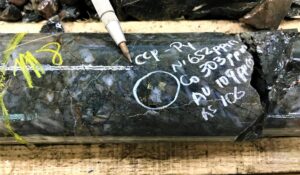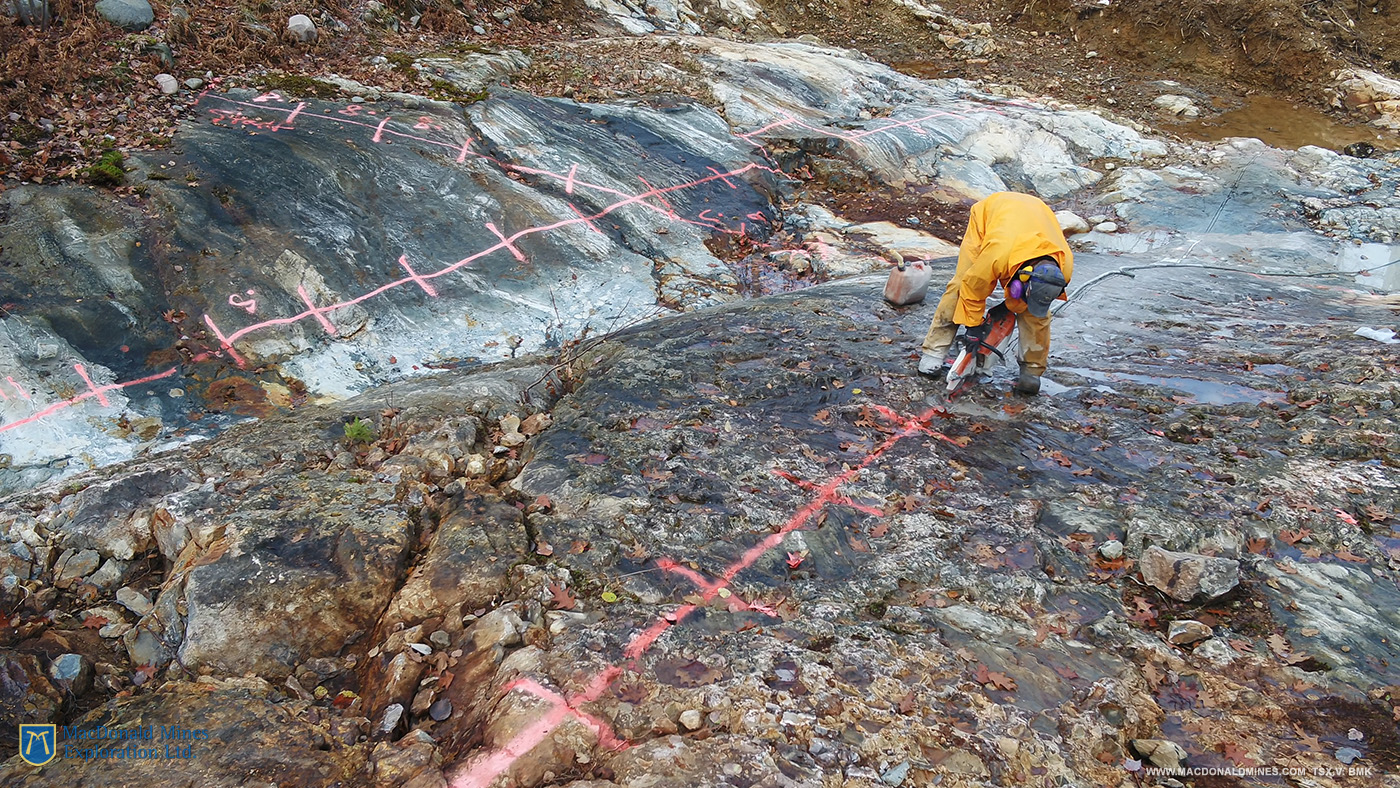MY OWN THOUGHTS - If i told you i have chlorite or serpentine rock, you would know it is so.
If i had nickel with in the chlorite or serpentine rock, but the xrf detector only detected the
greater mineral, such as chlroite / chlorine - then... technically, i'd still be correct.
My answer ( chlorite ) is in essence - correct on a technicality.
Iron sulphide can turn green and blue;
But... nickel is known to run with - iron sulphides.
If my ( iron ) sulphide or chloride is the greater percentage in say... hydroxide form.
Then... what would an xrf detector reveal ?
Most likely the greater iron content.
Here is that one core speciment with - nickel presence -
I would say... a piece of the nickel that didn't dissolve in, sulphide or chloride, was detected by
the xrf - detector - an easy discrimination due to the - nickel was not altered in sulphide or chlorite hydroxide.
Notice - the core is whole, has not seen assaying.
Whichpoints to - xrf detected the - nickel - most likley an easy nickel - chunky piece -
But.. .what if more nickel was mixed with an iron sulphide and when to solution - hydroxide ?
I would say.... one would have to rely on other testing means - to separate the hydroxide ions
to know for certain - and not rely on - a higher value or dominat mineral to over ride another.

IS NICKEL HARD TO DETECT ?
Yes... yes it is.
When nickel has been altered to a - HYDROXIDE -
Some will revert to - DMG - testing, using ammonia which has - nitrate.
Nickel chloride reacts with dimethylglyoxime in the presence of ammonium hydroxide to form a bright red coloured precipitate of bis-(dimethylglyoximato)nickel(II) complex. Characteristic Reactions of Ni²
Nickel(II) ion forms a large variety of complex ions, such as the green hydrated ion, [Ni(H2O)6]2+
Nickel(II) sulfide is not precipitated by adding in an acidic solution. In spite of this,
is only slightly soluble in and has to be dissolved in hot nitric acid or
aqua regia, because
NiS changes to a different crystalline form with different properties.
No Reaction
So... as one can see... nickel hydroxide can be a difficult mineral to detect.
If one was scanning cores and selecting " specific cores " in which to send in for assaying...
And if only -fire assay was performed -
Then... one would have ot backtrack to " recheck " all cores for the potential of a nickel hydroxide.
DETETING - NICKEL HYDROIXDES ( good photos to explain ) https://chem.libretexts.org/Bookshelves/Analytical_Chemistry/Supplemental_Modules_(Analytical_Chemistry)/Qualitative_Analysis/Characteristic_Reactions_of_Select_Metal_Ions/Characteristic_Reactions_of_Nickel_Ions_(Ni%C2%B2%E2%81%BA) Here's a wonderful specimen - lots of blue sulphides and iron.
The kind of ore - nickel would run in.

Now... prepare yourself....
Would a small ineral detector pick up on - nickel in heavy irons ?
Or... would the irons dominate so muchthat the detector - dtects only iron ?

if others opened up the other link above -
did anyone notice that - nickel - can also present itself as, brown ?
That's something new for me... i never knew this.
Yet, another color in which nickel can come in.

i would say....
It's not hard to do a double take...
The Geo... found incredible outcrops with significant sulphides...
All sorts of colors, greens, blues, all kinds of pyrites, a rea lgood mix.
But... a Ge is only as good as their equipt.
Geo checks the cores and identifies each core to be sent in for assaying.
If the company gave the Geo a cheap ola metal detector - not the Geo's faiult.
In other words - if a cheap detector couldn't identify the nickel - it's not the Geo's fault.
If company only tested for - gold. Then, they didn't cover their bases.
And... lastly... at the lab, only fire assays.
But... it can go one step futher... if a company did ask a lab to check for nickel...
And if sodic intrusion is prominent - then.... sulphide and chloride nickel require far more
measures - higher scrutiny - to detect the nickel.
Would love to see a Geo from Suds...
Run thier own (hgh end ) $50,000 XRFunit - over these outcrops...
You know.... just to see what it detects....
Thing is.. .maybe someone already has....
Wink.

What elements Cannot be detected by XRF?
XRF not effective for lithium, beryllium, sodium, magnesium, aluminum, silicon, or phosphorus: The XRF cannot detect common elements that are considered to be “light” elements, such as lithium, beryllium, sodium, magnesium, aluminum, silicon, and phosphorus.Aug 2, 2008
Now... to make sense of this statement above ?
Sodium = chlorite
Magnesium + Aluminum = nickel can bod with these
Phosphorus = uranium hides in this - element.
Nickel... changes to a salt chloride - and if xrf detectors can't detect sodiums, and BMK is in a sodic intrusion, then... XRF is not the device to be using - especially when nickel can convert to sulphide, chlroide, serpentines, hydroxides, and hide in amny pyrites, pentlandite, aresonpyrite, even basic pyrite, and... bond with aluminum and magnesium.
Cheers.....